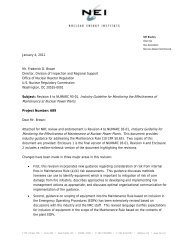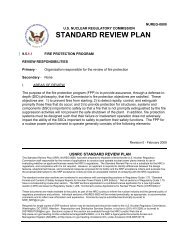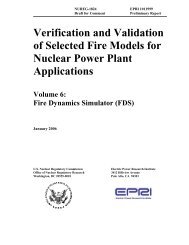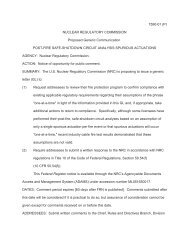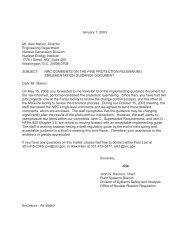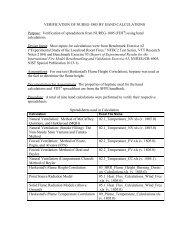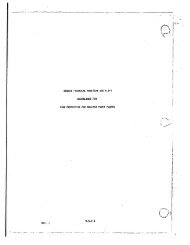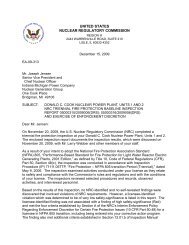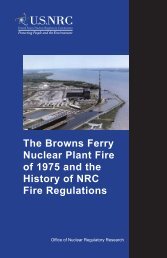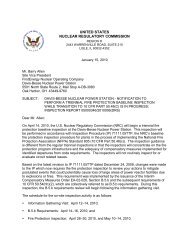NUREG/CR-6850, Volume 1 - NRC
NUREG/CR-6850, Volume 1 - NRC
NUREG/CR-6850, Volume 1 - NRC
Create successful ePaper yourself
Turn your PDF publications into a flip-book with our unique Google optimized e-Paper software.
Conclusions and Closing Remarksfailures, a hot short that even partially opened the MOV might lead to permanent damage andrupture of the low pressure piping. In such a case any prior or subsequent shorting behavior andconsiderations of hot short duration would be essentially irrelevant to the risk calculation. Forsuch a case, the expert panel results might well be the most appropriate interpretation of theavailable data.The above examples illustrate the complexity of the problem. Refinement of any given spuriousactuation likelihood value requires a clear understanding of the available data, consideration ofthe specific circuit configuration, and a clear understanding of the Fire PRA application andscenario implications. The team has identified, but not resolved, some mismatches between theexpert panel values and Fire PRA applications. Cases such as this suggest, for example, thatevent tree type methods might provide added insights regarding the relative likelihood of variouscircuit/component end states tailored to a specific circuit.Based on our insights to date, additional efforts to refine the quantitative methods associatedwith Task 10 are recommended. In particular, as additional data on cable failure modes andlikelihood becomes available, estimates for the spurious actuation likelihood should be updated.Even supplemental analysis of the existing data could provide new insights not incorporated inthe current estimates. It is also suggested that supplemental methods of circuit likelihood analysisfor Fire PRA could be developed. For example, the application of event tree approaches to agiven circuit might yield more realistic results.3.3.3 Dynamic Versus Static Modeling of Fire Damage and Operator ResponseBoth failure sets and operator response are modeled in the context of static interface conditions.That is, fire leads to loss of a full target set, then operators respond. Fire damage time is assessed,but only in the context of a full target set. Operator response considers the available time, butdoes not consider operator actions in the context of an ongoing fire with progressive fire damage.This approach does not, for example, take credit for the anticipatory diagnostic process thattakes place among the operators concurrent with the fire event. Even though the impact of thisapproach on the results and conclusions is unknown, it is expected that selecting fire effects thatrepresent the largest damage set taken at one point in time should be conservative for most firescenarios.3.3.4 Multiple FiresThe issue here is not one fire that spreads to secondary combustibles, nor is it a fire initiated inone compartment that spreads to a second compartment; rather, it relates to the occurrence of twoor more fires concurrently and in different locations due to the same root cause. Such cases aregenerally tied to electrical equipment failures. While the proposed methods can handle someaspects of problem (e.g., one can model the impact of two fires in two areas), an integratedapproach to the analysis of such events is lacking (e.g., frequency, where to put multiple fires,establishing common cause/root cause ties, etc.). The risk importance of multiple fire scenariosremains uncertain. Events of this type have occurred both in the U.S. and abroad [3.6], but arerare.3-9





